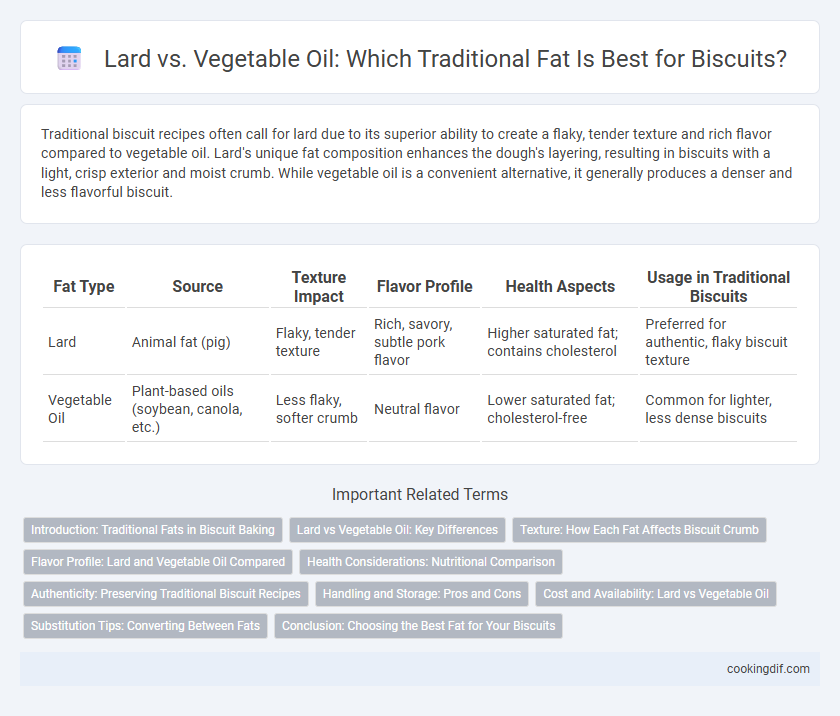Traditional biscuit recipes often call for lard due to its superior ability to create a flaky, tender texture and rich flavor compared to vegetable oil. Lard's unique fat composition enhances the dough's layering, resulting in biscuits with a light, crisp exterior and moist crumb. While vegetable oil is a convenient alternative, it generally produces a denser and less flavorful biscuit.
Table of Comparison
| Fat Type | Source | Texture Impact | Flavor Profile | Health Aspects | Usage in Traditional Biscuits |
|---|---|---|---|---|---|
| Lard | Animal fat (pig) | Flaky, tender texture | Rich, savory, subtle pork flavor | Higher saturated fat; contains cholesterol | Preferred for authentic, flaky biscuit texture |
| Vegetable Oil | Plant-based oils (soybean, canola, etc.) | Less flaky, softer crumb | Neutral flavor | Lower saturated fat; cholesterol-free | Common for lighter, less dense biscuits |
Introduction: Traditional Fats in Biscuit Baking
Traditional fats in biscuit baking primarily include lard and vegetable oil, each impacting texture and flavor distinctly. Lard, rendered from pork fat, contributes a flaky, tender crumb and rich taste prized in classic biscuits. Vegetable oils, often soybean or canola-based, offer a neutral flavor and consistent moisture retention, making them a popular alternative in modern baking.
Lard vs Vegetable Oil: Key Differences
Lard and vegetable oil differ significantly in composition and culinary properties, with lard being animal fat rich in saturated fats, providing a flaky texture and robust flavor ideal for traditional biscuits. Vegetable oil, typically derived from seeds, contains more unsaturated fats and produces a lighter, softer biscuit with a neutral taste. Choosing between lard and vegetable oil affects the biscuit's crumb structure, mouthfeel, and overall flavor profile, influencing final texture and baking performance.
Texture: How Each Fat Affects Biscuit Crumb
Lard creates a flakier, more tender biscuit crumb due to its larger fat crystals that effectively separate dough layers during baking, resulting in a delicate, airy texture. Vegetable oil produces a more uniform, softer crumb but lacks the distinctive flakiness because it disperses more evenly throughout the dough. The choice between lard and vegetable oil significantly impacts the final biscuit texture, with lard preferred for traditional flakiness and oil for a softer, more cake-like crumb.
Flavor Profile: Lard and Vegetable Oil Compared
Lard imparts a rich, savory flavor with subtle pork undertones that enhance the biscuit's depth, while vegetable oil offers a neutral taste allowing other ingredients to shine. The natural tenderness and flaky texture of biscuits made with lard are often preferred by traditional bakers due to its solid fat consistency at room temperature. Vegetable oil creates a softer crumb but lacks the distinctive mouthfeel and aroma that lard provides in classic biscuit recipes.
Health Considerations: Nutritional Comparison
Lard contains higher saturated fats and cholesterol, which may increase the risk of heart disease, while vegetable oils generally offer unsaturated fats that support heart health and reduce inflammation. Vegetable oils, such as olive or canola, provide essential omega-3 and omega-6 fatty acids, contributing to improved cholesterol levels and overall cardiovascular benefits. Choosing vegetable oil over lard in biscuit recipes aligns with modern nutritional guidelines focused on lowering saturated fat intake and promoting healthier lipid profiles.
Authenticity: Preserving Traditional Biscuit Recipes
Lard maintains unmatched authenticity in traditional biscuit recipes by providing a rich, flaky texture and distinct flavor that vegetable oils cannot replicate. Its solid fat content at room temperature creates desirable layers, preserving the original biscuit structure favored in classic baking. Using vegetable oil often results in a softer crumb and lacks the traditional taste profile essential for genuine biscuits.
Handling and Storage: Pros and Cons
Lard offers superior stability at room temperature, reducing the risk of rancidity during storage, while its solid state demands precise melting for consistent dough handling. Vegetable oil, being liquid at ambient temperatures, simplifies mixing and spreading in biscuit preparation but has a higher susceptibility to oxidation, necessitating airtight storage. Choosing between lard and vegetable oil impacts shelf life, texture uniformity, and requires tailored storage conditions to maintain biscuit quality.
Cost and Availability: Lard vs Vegetable Oil
Lard typically costs more than vegetable oil due to its animal origin and limited production compared to widely available plant-based oils. Vegetable oil offers greater availability, especially in large-scale baking operations, making it a cost-effective choice for biscuit production. Both fats impact biscuit texture differently, but from a cost and availability perspective, vegetable oil is generally more accessible and affordable.
Substitution Tips: Converting Between Fats
When substituting vegetable oil for lard in biscuit recipes, use about 75% of the oil amount to maintain the desired dough consistency and flakiness. Lard's higher melting point creates a tender, flaky texture that vegetable oil's liquid state can't fully replicate, so chilling the dough thoroughly helps compensate. For best results, combine vegetable oil with a small amount of solid fat like butter or shortening to mimic lard's structure.
Conclusion: Choosing the Best Fat for Your Biscuits
Lard offers biscuits a flaky texture and rich flavor due to its high saturated fat content, making it ideal for traditional recipes. Vegetable oil provides a lighter, less dense crumb but lacks the depth of flavor found in lard-based biscuits. Selecting the best fat depends on the desired biscuit texture and flavor profile, with lard preferred for classic flakiness and vegetable oil for a softer, more neutral taste.
Lard vs Vegetable oil for traditional fat Infographic

 cookingdif.com
cookingdif.com